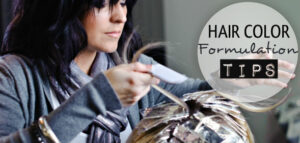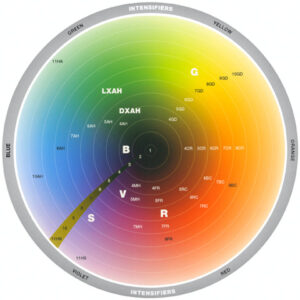Follow our Hair Color Formula Guide to create your client’s best hair color yet! Knowing these tips will ensure absolute color success.

1) Know Thy Color Wheel

Color Theory is Cosmetology 101!
Understanding the relationship between colors is essential when formulating your client’s ideal hair color.
The Color Wheel is comprised of 3 Primary Colors: Red, Yellow, Blue, and 3 Secondary Colors: Green, Violet, Orange. Tertiary Colors are created by combining a primary color with the secondary color beside it on the Color Wheel. Example: Yellow-Orange
Knowing which of these colors enhance and cancel out one another is vital for formulating the correct hair color. For example, if you’re looking to eliminate unwanted warmth (red), selecting a cooler tone (green) will effectively neutralize the previous color.
2) Know Predominant Tones
Every color line has various predominant tones (background pigment found in each hair color tube or bottle).
When formulating your client’s perfect hair color, it’s important to know the different background pigments present in your color line. For example, one line’s ‘N-series’ or ‘neutrals’ could fall on the warmer side of the Color Wheel; whereas, another line could have a tonal value at the blue-violet base.
If you aren’t aware of your color line’s predominant pigments, then you will not be able to accurately use the Color Wheel to create your client’s desired color.
3) Determine Client’s Natural Level
Hair color will range from levels 1-10. Level 1 being the darkest and Level 10 being the lightest color.
Within each of those levels are the 2 underlying color pigments: eumelanin (black-brown) and pheomelanin (red-brown), which control the shade of the hair. Dark hair (levels 1-4), contain high concentration of red pigment; whereas, blonde hair (levels 7-10) consists of mainly golden pigments. If your client’s level is somewhere in the middle (levels 5-6), more orange pigments are present in the hair, a combination of red and yellow.
Whether you are lifting or depositing, knowing which tones are present in your client’s natural level will help you make a better color choice.
4) Understand Grey Vs. White Hair
Grey and white hair are not the same, and should not be treated as such.
Grey hair still contains some pigment; whereas, white hair color does not. Often, not knowing the difference between white and grey hair can result in muddy color results or lack of proper pigment load.
Think about it.
White hair is completely absent of pigment. If you mix the colors white and red, what would be the result? Pink!
When dealing with white hair it necessary to add the missing anchor pigments to give the color you’re depositing something to hold on to.
Grey hair is actually an optical illusion, it contains both the color of pigmented hair and white hair. Since grey hair still contains some pigment, it should be formulated differently than white hair.
In addition, knowing the ratio of white or grey hair to pigmented hair is necessary when formulating. For example, if hair is 75% grey, you may want to consider lowering your developer to color ratio – allowing for more color than developer, or dropping down a level for ample pigment weight.
5) Consultation is Key
As a professional Hair Stylist, it’s your job to direct and steer the consultation with your client.
Client’s may think they are in the driver’s seat, but you’re the instructor with the emergency peddle – pump the breaks when necessary to avoid a hairy disaster!
For example, if your client’s hair is in poor condition and would not be able to withstand a perm or extreme lightening service, then don’t be afraid to speak up.
Also, be sure you and your client are on the same page when it comes to color selection.
More than likely, you and your client’s idea of a ‘honey blonde’ or ‘red-brown’ will vary. We suggest having them bring in a few photos of their desired color, and having them point out what they do and do not like about each picture.
This will give great insight when formulating, and help you understand what your client expects from their color service.
You should also be inquiring if your client is currently taking any medications.
Medications for the heart and thyroid are just some of the medication types that can completely alter your color results.
PRO TIP: Use Malibu’s Crytal Gel for 100% removal of build up, medications, and hard water minerals prior to your color service.
6) Determine Hair’s Porosity, Density, & Texture
The importance of determining the health of your client’s hair and their hair type cannot be overstated.
Fine, medium, and coarse hair all absorb color differently.
Damaged and pre-lightened hair tends to be more porous. Porous hair tends to over accept color (especially ash tones), so depending on your desired result, your formula will have to take into consideration the hair’s porosity level.
Additionally, the more porous the hair, the less amount of processing time and developer volume is needed.
If hair is overly porous or coarse and resistant (e.g., grey hair), you’ll need to treat the hair prior to your color service.
For instance, if hair is porous, it is lacking protein, and could use a protein treatment.
Note: Use a treatment with the proper pH; actual conditioner will close the cuticle, making it more difficult for color molecules to be absorbed into the hair.
PRO TIP: Try Powerbuild Reconstructor (80% protein, 20% moisture)
P.S. Just like Miley Cyrus and raunchy publicity stunts, protein and color molecules are attracted to each other; adding protein to the equation will help your hair color be richer and longer lasting!
If hair is coarse, the cuticle scales are tightly packed down and need to be softened. Treating the hair prior to service will allow the hair’s cuticle to open and accept the color, all without using a stronger developer.
PRO TIP: Try Aquaboost Reconstructor (80% moisture, 20% protein)
Also, different nationalities tend to yield different hair textures.
For example, Asian hair tends to be very round shaped, and African-American hair tends to be quite flat. The natural shape of the hair will affect hair’s texture and consequent processing time.
7) Know Your Developer Strengths
Understand the lifting ability of your developers!
Each color line’s developers will vary in strength.
One line’s 20 volume developer may give you 1-2 levels of lift, where some color lines will just deposit. The power of each developer should be known before mixing it with a color or lightening powder, so that the structural integrity of the hair is kept intact.
FRIENDLY REMINDER: Color doesn’t lift color, at least not with predictability.
8) Proper Mixing
Knowing your color to developer mixing ratio is vital to color success!
For example, most High Lift blonde series will require a larger amount of developer. Instead of mixing color to developer of 1:1, high lift blonde will need the added strength of more developer to get to a lighter lever, so use a mixing ratio of 2 (developer):1 (color).
Also, be sure to accurately assess the amount of hair your client has. That way, you don’t have to go mix more color while the applied color is processing on the hair.
9) Proper Processing Time
A numerous amount of factors will affect your color’s processing time!
Here’s a few to take into consideration:
- Health of Hair
- How Many Levels of Lift
- Percentage of Grey or White Hair
- Strength of Developer Used
- Hair Texture
Also, be sure to consult your manufacturer’s Technical Manual for recommended color processing times; these will vary color line to color line.
10) Phone a Friend!
When we say phone a friend, what we really mean is don’t be afraid to contact Tech Support for your color line!
This is especially true if you’re a new user to your color line. Tech Support will more than likely be armed with a plethora of tools such as, conversion charts and tech tips that will help you become a raving success with your new color, so don’t be afraid to ask questions!




